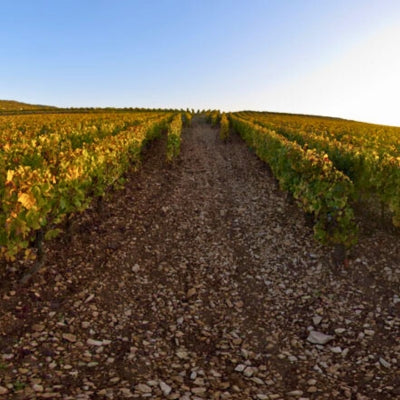
Understanding terroir: the role of soil, topography and water
In this third part of our series on terroir, Westgarth Wines specialist Maurizio Broggi explores the influence of soil, water and topography on the character of a wine.
While climate impacts terroir, French experts often emphasize soil’s role. Soil significantly affects and regulates the water supply to the vines, a factor that is deemed essential in the development of superior terroirs.
Some of the most renowned vineyards in regions like Bordeaux and Burgundy are situated on diverse soils with distinct geological, chemical, and physical characteristics.
However, common factors among these vineyards – such as moderate but adequate nutrient levels, a balanced water supply that curtails excessive vine growth, and optimal drainage to prevent waterlogging – play a significant role in the consistent quality of their wines.
The role of soil
The ability of soil to manage water availability directly influences vine health and grape quality. Excess water delays ripening and dilutes flavor, while too little stresses the vines excessively.
The best terroirs maintain a delicate water balance, fostering healthy vine development while enhancing flavor concentration in the grapes. This water balance supports consistent quality, even in tough vintages.
Examples of these exceptional soils include the heavy, well-structured clay-based soils in Pomerol, which contribute to the region’s full-bodied wines. In the Médoc, the deep, stony-gravelly sands are renowned for providing excellent drainage, a key factor in producing Cabernet Sauvignon with depth and intensity. Burgundy's finest grand cru vineyards feature a combination of limestone and clay in marly soils, lending a unique mineral quality and structure to the wines.
Soil composition and water management
Old World producers tend to focus on soil type, but studies show water management may be key. For example, in the vineyards of Champagne and Chablis, chalky soils derived from parent rock provide excellent drainage and allow roots to penetrate deep into the subsoil. This setup ensures stable water supply and adds unique minerality.
However, whether soil composition directly influences wine taste remains debated. Some experts, like Emeritus Professor Alex Maltman, argue that soil’s impact on wine flavors is indirect, largely through its effects on water availability and vine health. Jamie Goode has also suggested that the perception of "minerality" in wines could stem from winemaking practices rather than soil composition alone. Nonetheless, the soil’s role in water management undeniably shapes the balance between vegetative growth and fruit ripening, which ultimately affects grape quality and wine style.
Water supply, vine vigor, and grape quality
Studies from New Zealand and Australia have highlighted that soil’s water relations are crucial for grapevine growth, especially regarding vine vigor, which affects grape quality. Vines in soils that maintain a moderate water supply without excessive nitrogen often exhibit restrained growth, fostering a balance between canopy size and grape clusters. A balanced canopy allows sunlight in, aiding ripening and flavor.
In regions with high-quality vineyards, limited water and nitrogen control vigor, focusing vines on fruit over foliage. This controlled growth leads to more balanced wines with well-integrated flavors. Thus, the ability of soil to moderate water and nutrient availability is central to its role in terroir.
The influence of topography on terroir
Topography, or the physical shape and slope of the vineyard site, can be as crucial as soil. The steep, south-facing slopes overlooking the Moselle River in Germany’s Mosel region, for example, are crucial for producing some of the world’s most distinctive expressions of German Riesling. The slate-based soils and steep topography allow the vines to receive maximum sunlight exposure, crucial for ripening grapes in this cooler climate, and retain heat to protect against overnight temperature drops.
In Burgundy, the Grand Cru vineyard of Montrachet is a prime example of a terroir expression shaped by topography. Differences in the aspect and position on the slope lead to stylistic differences among the wines from various parcels. Burgundy expert Charles Curtis MW notes the orientation differences shaping Montrachet’s character: Puligny-Montrachet wines tend toward racy finesse, while Chassagne-Montrachet offers richer, denser wines.
Montrachet: a case study in soils and slopes
The Montrachet vineyard’s location mid-slope also affects the character of its wines by influencing soil depth. Positioned between the mineral-rich, shallow soils of Chevalier-Montrachet upslope and the slightly heavier soils of Bâtard-Montrachet downslope, Montrachet benefits from a unique combination of factors. The mid-slope soil balance sustains vines while encouraging root competition, concentrating flavors.
These small yet crucial variations in soil depth and slope aspect reveal why Montrachet wines show a range of distinctive qualities even within a single grand cru. Soil and slope create layered terroir, adding stylistic nuance to this celebrated vineyard.
The interplay between soil, topography and water
Together, soil, topography, and relations create a complex system that defines terroir. Soil controls water and can add minerals affecting vine health and grape quality. Topography determines how much sunlight the vines receive and helps create microclimates within a vineyard, which can be the difference between a good wine and an exceptional one. Water availability and regulation, facilitated by soil and slope, are critical to maintaining vine balance, which supports healthy grape development. This intricate combination explains why specific vineyard sites consistently yield high-quality wines with distinct characteristics year after year.
Stay tuned for Part IV of our series on terroir, which discusses climate and the choice of grape varieties.
Want to read more? Take a look at some of our other blogs:



